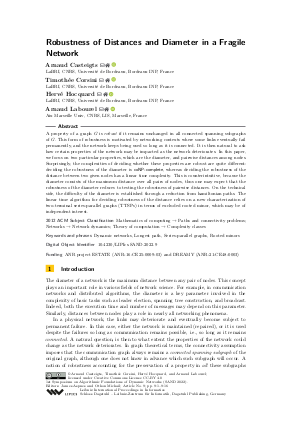Robustness of Distances and Diameter in a Fragile Network
Authors
Arnaud Casteigts  ,
Timothée Corsini
,
Timothée Corsini  ,
Hervé Hocquard
,
Hervé Hocquard  ,
Arnaud Labourel
,
Arnaud Labourel 
-
Part of:
Volume:
1st Symposium on Algorithmic Foundations of Dynamic Networks (SAND 2022)
Part of: Series: Leibniz International Proceedings in Informatics (LIPIcs)
Part of: Conference: Symposium on Algorithmic Foundations of Dynamic Networks (SAND) - License:
 Creative Commons Attribution 4.0 International license
Creative Commons Attribution 4.0 International license
- Publication Date: 2022-04-29
File

PDF
LIPIcs.SAND.2022.9.pdf
- Filesize: 0.72 MB
- 16 pages
Document Identifiers
Subject Classification
ACM Subject Classification
- Mathematics of computing → Paths and connectivity problems
- Networks → Network dynamics
- Theory of computation → Complexity classes
Keywords
- Dynamic networks
- Longest path
- Series-parallel graphs
- Rooted minors
Metrics
- Access Statistics
-
Total Accesses (updated on a weekly basis)
0Document
0Metadata
Abstract
A property of a graph G is robust if it remains unchanged in all connected spanning subgraphs of G. This form of robustness is motivated by networking contexts where some links eventually fail permanently, and the network keeps being used so long as it is connected. It is then natural to ask how certain properties of the network may be impacted as the network deteriorates. In this paper, we focus on two particular properties, which are the diameter, and pairwise distances among nodes. Surprisingly, the complexities of deciding whether these properties are robust are quite different: deciding the robustness of the diameter is coNP-complete, whereas deciding the robustness of the distance between two given nodes has a linear time complexity. This is counterintuitive, because the diameter consists of the maximum distance over all pairs of nodes, thus one may expect that the robustness of the diameter reduces to testing the robustness of pairwise distances. On the technical side, the difficulty of the diameter is established through a reduction from hamiltonian paths. The linear time algorithm for deciding robustness of the distance relies on a new characterization of two-terminal series-parallel graphs (TTSPs) in terms of excluded rooted minor, which may be of independent interest.
Cite As Get BibTex
Arnaud Casteigts, Timothée Corsini, Hervé Hocquard, and Arnaud Labourel. Robustness of Distances and Diameter in a Fragile Network. In 1st Symposium on Algorithmic Foundations of Dynamic Networks (SAND 2022). Leibniz International Proceedings in Informatics (LIPIcs), Volume 221, pp. 9:1-9:16, Schloss Dagstuhl – Leibniz-Zentrum für Informatik (2022)
https://doi.org/10.4230/LIPIcs.SAND.2022.9
BibTex
@InProceedings{casteigts_et_al:LIPIcs.SAND.2022.9,
author = {Casteigts, Arnaud and Corsini, Timoth\'{e}e and Hocquard, Herv\'{e} and Labourel, Arnaud},
title = {{Robustness of Distances and Diameter in a Fragile Network}},
booktitle = {1st Symposium on Algorithmic Foundations of Dynamic Networks (SAND 2022)},
pages = {9:1--9:16},
series = {Leibniz International Proceedings in Informatics (LIPIcs)},
ISBN = {978-3-95977-224-2},
ISSN = {1868-8969},
year = {2022},
volume = {221},
editor = {Aspnes, James and Michail, Othon},
publisher = {Schloss Dagstuhl -- Leibniz-Zentrum f{\"u}r Informatik},
address = {Dagstuhl, Germany},
URL = {https://drops.dagstuhl.de/entities/document/10.4230/LIPIcs.SAND.2022.9},
URN = {urn:nbn:de:0030-drops-159514},
doi = {10.4230/LIPIcs.SAND.2022.9},
annote = {Keywords: Dynamic networks, Longest path, Series-parallel graphs, Rooted minors}
}
Author Details
Funding
ANR project ESTATE (ANR-16-CE25-0009-03) and DREAMY (ANR-21-CE48-0003)
References
-
Ingo Althöfer, Gautam Das, David Dobkin, Deborah Joseph, and José Soares. On sparse spanners of weighted graphs. Discrete & Computational Geometry, 9(1):81-100, 1993.

-
Eli Berger, Paul Seymour, and Sophie Spirkl. Finding an induced path that is not a shortest path. Discrete Mathematics, 344(7):112398, 2021.

-
Arnaud Casteigts, Swan Dubois, Franck Petit, and John M Robson. Robustness: A new form of heredity motivated by dynamic networks. Theoretical Computer Science, 806:429-445, 2020.

-
R.J Duffin. Topology of series-parallel networks. Journal of Mathematical Analysis and Applications, 10(2):303-318, 1965.

-
David Eppstein. Parallel recognition of series-parallel graphs. Information and Computation, 98(1):41-55, 1992.

-
Cyril Gavoille, Quentin Godfroy, and Laurent Viennot. Node-disjoint multipath spanners and their relationship with fault-tolerant spanners. In International Conference On Principles Of Distributed Systems, pages 143-158, 2011.

-
Frank Harary. Graph Theory. Addison-Wesley Publishing Company, 1st edition, 1969.

-
John Hopcroft and Robert Tarjan. Algorithm 447: efficient algorithms for graph manipulation. Communications of the ACM, 16(6):372-378, 1973.

-
Kuo-Hua Kao, Jou-Ming Chang, Yue-Li Wang, and Justie Su-Tzu Juan. A quadratic algorithm for finding next-to-shortest paths in graphs. Algorithmica, 61(2):402-418, 2011.

-
Ilia Krasikov and Steven D Noble. Finding next-to-shortest paths in a graph. Information processing letters, 92(3):117-119, 2004.

-
Kumar N Lalgudi and Marios C Papaefthymiou. Computing strictly-second shortest paths. Information processing letters, 63(4):177-181, 1997.

-
Shisheng Li, Guangzhong Sun, and Guoliang Chen. Improved algorithm for finding next-to-shortest paths. Information processing letters, 99(5):192-194, 2006.

-
Karl Menger. Zur allgemeinen kurventheorie. Fundamenta Mathematicae, 10(1):96-115, 1927.

-
John Riordan and Claude E Shannon. The number of two-terminal series-parallel networks. Journal of Mathematics and Physics, 21(1-4):83-93, 1942.

-
Neil Robertson and Paul D Seymour. Graph minors. xiii. the disjoint paths problem. Journal of combinatorial theory, Series B, 63(1):65-110, 1995.

-
Jacobo Valdes, Robert E Tarjan, and Eugene L Lawler. The recognition of series parallel digraphs. In Proc. of the 11th ACM Symposium on Theory of Computing, pages 1-12, 1979.

-
Paul Wollan. Extremal functions for graph linkages and rooted minors. Georgia Institute of Technology, 2005.

